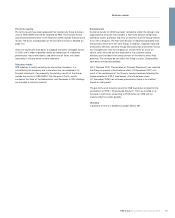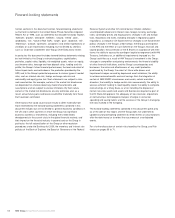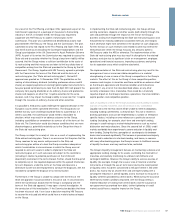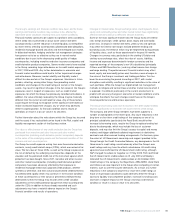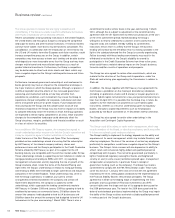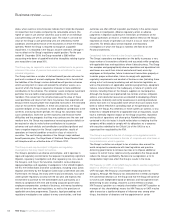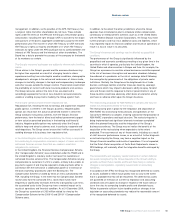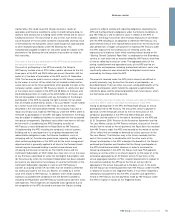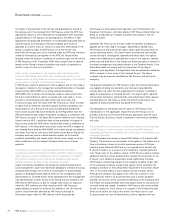RBS 2009 Annual Report Download - page 62
Download and view the complete annual report
Please find page 62 of the 2009 RBS annual report below. You can navigate through the pages in the report by either clicking on the pages listed below, or by using the keyword search tool below to find specific information within the annual report.RBS Group Annual Report and Accounts 200960
The Group’s business performance could be adversely affected if its
capital is not managed effectively or if there are changes to capital
adequacy and liquidity requirements.
Effective management of the Group’s capital is critical to its ability to
operate its businesses, to grow organically and to pursue its strategy of
returning to standalone strength. The Group is required by regulators in
the United Kingdom, the United States and in other jurisdictions in
which it undertakes regulated activities, to maintain adequate capital
resources. The maintenance of adequate capital is also necessary for
the Group’s financial flexibility in the face of continuing turbulence and
uncertainty in the global economy. Accordingly, the purpose of the
issuance of the £25.5 billion of B shares, the Contingent Subscription
and the previous placing and open offers was to allow the company to
strengthen its capital position. The FSA’s recent liquidity policy
statement articulates that firms must hold sufficient eligible securities to
survive a liquidity stress and this will result in banks holding a greater
amount of government securities, to ensure that these institutions have
adequate liquidity in times of financial stress.
In addition, on 17 December 2009, the Basel Committee on Banking
Supervision (the “Basel Committee”) proposed a number of
fundamental reforms to the regulatory capital framework in its
consultative document entitled “Strengthening the resilience of the
banking sector”. If the proposals made by the Basel Committee are
implemented, this could result in the Group being subject to significantly
higher capital requirements. The proposals include: (a) the build-up of a
counter-cyclical capital buffer in excess of the regulatory minimum
capital requirement, which is large enough to enable the Group to
remain above the minimum capital requirement in the face of losses
expected to be incurred in a feasibly severe downturn; (b) an increase
in the capital requirements for counterparty risk exposures arising from
derivatives, repo-style transactions and securities financing transactions;
(c) the imposition of a leverage ratio as a supplementary measure to the
existing Basel II risk-based measure; (d) the phasing out of hybrid
capital instruments as Tier 1 capital and the requirement that the
predominant form of Tier 1 capital must be common shares and
retained earnings; and (e) the imposition of global minimum liquidity
standards that include a requirement to hold a stock of unencumbered
high quality liquid assets sufficient to cover cumulative net cash outflows
over a 30 day period under a prescribed stress scenario. The proposed
reforms are subject to a consultative process and an impact
assessment and are not likely to be implemented before the end of
2012. The Basel Committee will also consider appropriate transition and
grandfathering arrangements. These and other future changes to capital
adequacy and liquidity requirements in the jurisdictions in which it
operates may require the Group to raise additional Tier 1 capital and
Core Tier 1 capital by way of further issuances of securities, including
in the form of ordinary shares or B shares. The requirement to raise
additional Core Tier 1 capital could have a number of negative
consequences for the company and its shareholders, including
impairing the company’s ability to pay dividends on or make other
distributions in respect of the ordinary shares and diluting the
ownership of existing shareholders. If the Group is unable to raise the
requisite capital, it may be required to further reduce the amount of its
risk-weighted assets and engage in the disposition of core and other
non-core businesses, which may not occur on a timely basis or achieve
prices which would otherwise be attractive to the Group. In addition,
pursuant to the agreement reached with the Commission, should the
Group’s Core Tier 1 capital ratio decline to below 5 per cent. at any time
before 31 December 2014, or should the Group fall short of its funded
balance sheet target level (after adjustments) for 31 December 2013 by
£30 billion or more, the Group will be required to reduce its risk-weighted
assets by a further £60 billion in excess of its plan through further
disposals of identifiable businesses and their associated assets. The
Group would also be subject to restrictions on payments on its hybrid
capital instruments should its Core Tier 1 ratio fall below 6 per cent. or
were it to fall below 6 per cent. as a result of such payment. As at
31 December 2009, the Group’s Tier 1 capital and Core Tier 1 capital
ratios were 14.1 per cent. and 11.0 per cent. respectively, calculated in
accordance with FSA definitions. Any change that limits the Group’s
ability to manage effectively its balance sheet and capital resources
going forward (including, for example, reductions in profits and retained
earnings as a result of write-downs or otherwise, increases in risk-
weighted assets, delays in the disposal of certain assets or the inability
to syndicate loans as a result of market conditions, a growth in unfunded
pension exposures or otherwise) or to access funding sources, could
have a material adverse impact on its financial condition and regulatory
capital position or result in a loss of value in its securities.
The value of certain financial instruments recorded at fair value is
determined using financial models incorporating assumptions,
judgements and estimates that may change over time or may ultimately
not turn out to be accurate.
Under IFRS, the Group recognises at fair value (i) financial instruments
classified as ‘held-for-trading’ or ‘designated as at fair value through
profit or loss’, (ii) financial assets classified as ‘available-for-sale’, and
(iii) derivatives, each as further described in ‘Accounting Policies’ on
page 252 of the financial statements. Generally, to establish the fair
value of these instruments, the Group relies on quoted market prices or,
where the market for a financial instrument is not sufficiently active,
internal valuation models that utilise observable market data. In certain
circumstances, the data for individual financial instruments or classes of
financial instruments utilised by such valuation models may not be
available or may become unavailable due to changes in market
conditions, as has been the case during the recent financial crisis. In
such circumstances, the Group’s internal valuation models require the
Group to make assumptions, judgements and estimates to establish fair
value. In common with other financial institutions, these internal valuation
models are complex, and the assumptions, judgements and estimates
the Group is required to make often relate to matters that are inherently
uncertain, such as expected cash flows, the ability of borrowers to
service debt, residential and commercial property price appreciation
and depreciation, and relative levels of defaults and deficiencies. Such
assumptions, judgements and estimates may need to be updated to
reflect changing facts, trends and market conditions. The resulting
change in the fair values of the financial instruments has had and could
continue to have a material adverse effect on the Group’s earnings and
financial condition. Also, recent market volatility and illiquidity have
challenged the factual bases of certain underlying assumptions and
have made it difficult to value certain of the Group’s financial
instruments. Valuations in future periods, reflecting prevailing market
conditions, may result in further significant changes in the fair values of
these instruments, which could have a negative effect on the Group’s
results of operations and financial condition or result in a loss of value
in its securities.
Business review continued



